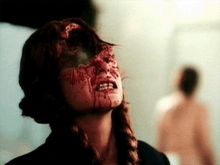Chopping Mall, originally released unsuccessfully as Killbots before a re-edit and title change turned it into a cult hit, is one of those quintessential '80s time capsules that is pretty hard to deny if you grew up in that era. And, yes, people like to point out that the title doesn't exactly make sense because the killer robots blast people with lasers instead of chopping them into bits, but c'mon, Chopping Mall is a great title, and it fits the spirit of the movie way better than the more accurate Killbots.Whatever you call it, you get killer robots inside a shopping mall with a cast full of cult favorites including Barbara Crampton, Kelli Maroney, Dick Miller, Paul Bartel, Mary Woronov, and Gerrit Graham. Yeah, those last four are just cameos, but they're solid cameos.
Filmed at the Sherman Oaks Galleria (the same mall used in Fast Times at Ridgemont High, though, from the looks of Chopping Mall, the Galleria received an '80s makeover in the interim), Chopping Mall's mall is debuting three new overnight security guards who just happen to be robots. These supposedly fool-proof robot mall guards turn into killers when their control system's roof antenna is hit by lightning. Unfortunately for all of us, a group of party animals in their early twenties have decided to dance, drink, have sex, and watch Roger Corman's Attack of the Crab Monsters in the mall's furniture store after hours.
Let's introduce this quintessentially '80s group by gender, as was the style of the time. The boys: We have the man who is reluctantly making this furniture store beer bash happen, the nerdy Ferdy (The Karate Kid's Tony O'Dell; also the second Head of the Class series regular who has been in a movie reviewed on this site in the last month), the store's bookkeeper and the nephew of the owner; his coworkers Mike (John Terlesky), an overconfident jock with sex and beer on the brain, and Greg (Nick Segal, nephew of George Segal, who chucked his acting career aside after a few movie and TV roles to work in real estate), a preppier, less meathead version of Mike; and Rick (Russell Todd), a leather-jacketed mysterious bad boy type. The only things uniting our disparate band of dudes are horniness and easy access to a furniture store in the mall. And, eventually, malfunctioning robots trying to kill them.
Last, but certainly not least, the ladies: Rick's wife Linda (Karrie Emerson), a sexy yet rugged type who knows how to fix the engine of a pickup truck and make Molotov cocktails; sexy sex bomb Leslie (Suzee Slater), girlfriend of Mike and daughter of the mall's clothing store owner, who knows what she wants and knows how to get it; sexy party animal with a heart of gold Suzie (Re-Animator's Barbara Crampton), a waitress in the mall's diner and Greg's girlfriend; and, finally, Suzie's coworker, sexy seemingly naive goody-two-shoes Alison (Night of the Comet's Kelli Maroney), who is secretly not so naive.
Ferdy continues freaking out about the party at his uncle's store (key line from Greg after Ferdy says the party can't start until he finds a missing fuchsia pattern for a customer: "Fuck the fuchsia. It's Friday!"), but changes his tune when he gets one look at Alison. The mall closes. The dance party begins. (This movie really makes it seem like a blast to party in a furniture store after hours, minus the killer robots.) Beer is chugged (our lovable nerds Ferdy and Alison drink wine). After the beer is chugged, every couple starts having sex, except for Ferdy and Alison, who watch Attack of the Crab Monsters and make out a little bit. Greg offends Suzie by telling her she smells like pepperoni, but she is coaxed back to the sofa when he says, "Hey, I LIKE pepperoni!"
After everyone's horniness is somewhat satiated, Leslie sends Mike to the cigarette machine to get her a pack of her beloved Virgin Lights. Mike grumbles until Leslie flashes her breasts, which makes him spring into action. Unfortunately for Mike, cigarettes aren't the only thing at the vending machine. You're damn right I'm referring to a killer robot. From this point on, the movie turns into a fight to the death between a bunch of sexy, immature young adults and a trio of killbots. Some will give all. All will give some. Fortunately for our heroes, this mall sells guns and ammo. Many viewers have expressed skepticism a mall would contain a
guns-and-ammo shop or a furniture store, but none of these nitpicky
clowns have a problem with the store glimpsed in the background of
several shots that ONLY SELLS ALMONDS!!!
The second film from b-movie veteran Jim Wynorski (his credits include Not of This Earth, The Return of Swamp Thing, Dinosaur Island, Ghoulies IV, The Bare Wench Project II: Scared Topless, The Devil Wears Nada, Busty Cops Go Hawaiian, Dinocroc vs. Supergator, and Sexipede!, just to name a few), Chopping Mall benefited from the production guidance of Julie Corman, wife of Roger Corman and excellent low-budget producer in her own right, with legends like the aforementioned Bartel, Woronov, Miller, and Graham doing their thing, small-dose style.
Chopping Mall is not the movie I'd pick if someone asked me to put together twenty of the 1980s horror greats, but it's a lot of fun, with plenty of destruction, carnage, nudity, wisecracks, and cheap-looking lasers, and the mall is always a great horror setting. Sometimes, you just need a good time, and Chopping Mall delivers.




















